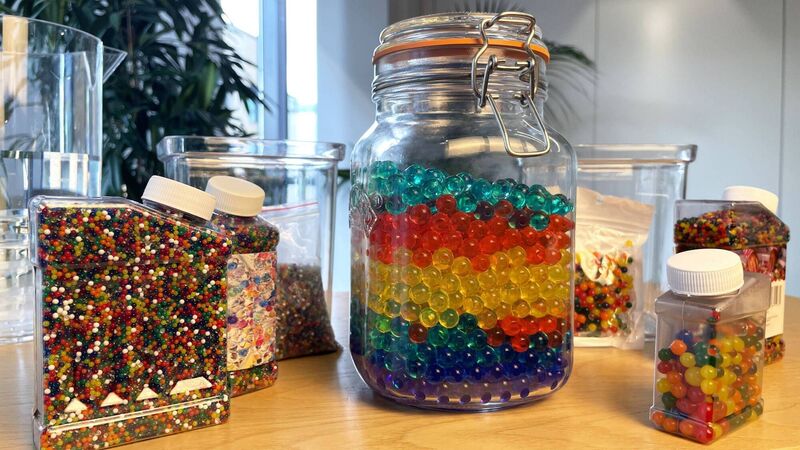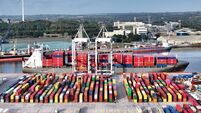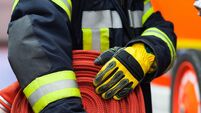Safety warning issued on gel water beads

There have been a number of reported incidents around the world involving water beads, including blockages in ear canals and internal organs, resulting in hearing loss and bowel obstruction.
The Competition and Consumer Protection Commission (CCPC) has issued a warning to parents and caregivers about water beads.
Also known as gel beads, sensory beads and by a number of other trademarked names, these small plastic spheres are made of a superabsorbent polymer and can retain hundreds of times their weight in water.
Thanks in no small measure to promotion on social media, they’ve been increasing in popularity in the last few months. The problem is that water beads present a serious risk for babies and toddlers, which is why the CCPC has issued an advisory bulletin warning that they should be kept out of sight and reach of young children.
Water beads start out as tiny pellets, but they gradually expand when soaked in water. They’re often used as sensory toys, and more recently in pellet and water guns. Because they’re small and colourful, they’re instantly attractive to toddlers and babies, who may instinctively put them in their mouths.
So water beads are first and foremost a choking hazard. If swallowed, they can continue to expand, growing considerably larger than their original size, causing intestinal blockages which require medical intervention. The beads also can become lodged in a child’s ears or nose.

The CCPC reports that there have been a number of reported incidents around the world involving water beads, including blockages in ear canals and internal organs, resulting in hearing loss and bowel obstruction.
Whilst water beads appear harmless, it’s important for parents and caregivers to take a number of safety precautions. Keep water beads away from young children, and supervise older children when they’re using them. Don’t allow anyone to play with them until after the beads have expanded.
Make sure that water beads are thoroughly cleared away after use, checking under furniture or other objects for any that may have rolled away. Dispose of them safely.
It’s also a good idea to keep older and younger siblings’ toys separate. This can help prevent younger children from getting their hands on toys that are not age-appropriate. Staying on that subject, always check the recommended age range which is always displayed on the packaging of toys. Most water beads are only recommended for children of five years and older.
If you suspect that a child in your care has inhaled or swallowed a water bead, or has one lodged in their nose or ear, get medical help immediately.
While this warning doesn’t suggest that there is anything inherently unsafe about water beads, as long as they are kept out of reach of young children, product recalls and alerts happen all the time.
‘Safety Gate’ is an EU-wide system that allows consumer authorities across the EU to share information about dangerous non-food items that have made their way onto the market. Each alert contains information on the product, a description of the risk and the measures taken to deal with it. Every alert is followed up by authorities in each of the member states, who take action if they find the same product in their markets.
In 2022, authorities from the 30 participating countries of the Safety Gate network (EU member states plus Norway, Iceland and Liechtenstein) reacted to 2,117 alerts with 3,932 follow-up actions.

According to Safety Gate’s just-released annual report, risks related to chemical substances, injuries and choking were notified most often. Toys topped the list, followed by motor vehicles, cosmetics, clothing and electrical appliances.
The CCPC continues to highlight the risks posed to consumers by poor quality, unsafe or non-compliant products, and toys in particular. The commission has created a checklist of what to look out for to make sure consumers are safety aware.
First of all, check for the CE mark on children’s toys before you buy them. The CE mark is a manufacturer’s declaration that the product complies with EU safety regulations and standards.
The mark should be easy to see, either on the product, in the instruction manual or on the packaging. When buying toys online, check for the CE mark as soon as the package arrives. If there’s no visible CE mark, send it back. Under consumer protection law, you have 14 days from when the goods arrive to notify the business that you wish to cancel your order, and a further 14 days to return the goods.
Second, always buy from a reputable dealer. This will help you to avoid unsafe, non-compliant toys, or indeed toys with a fake CE mark.
If you’re buying online, it can be hard to know who exactly you’re buying from, so it’s important to do a little research, check reviews and social media pages. If you can’t easily find where the business is based, approach with caution.
And if the business is based outside of the EU, try to find an alternative trader within the EU so that you have the protections guaranteed by European consumer law.
As we’ve seen, one of the biggest dangers for children is small or detachable parts of toys, because these can lodge in little ears, noses and throats. A €2 coin is a good reference point. Anything smaller is a potential choking hazard for children aged up to three years.
Check age guidance instructions on all children’s toys, in particular those designed for children under three. Age labelling is the manufacturer's way of telling you whether the toys are safe for a child of a particular age. And as with water beads, it’s important to consider any younger children who may be in the same house as the intended recipient.
Finally, check for sharp edges, long cords or cables. Be sure to avoid dangerous or fold-away parts, or small holes that could trap children’s fingers.
Product recalls are now a standard feature of the consumer landscape. Last Friday alone, the CCPC issued two separate recalls, one for a table lamp sold on Amazon and one for a wall-mounted charger sold in Homesense and TK Maxx.
What do you do if you’ve bought a product that’s been recalled? First off, let the retailer know. It may turn out to be a once-off fault in which case you are entitled to a repair, a replacement, a reduction in the price or a refund. You will need proof of purchase such as a receipt or bank or credit card statement.
If you’re still not satisfied, get in touch with the CCPC. If you hear about a product recall and think you’re affected, check the product recall details on the CCPC site. It may only be a specific batch being recalled, or it might just affect certain countries.
And if you are have found an unsafe product,










